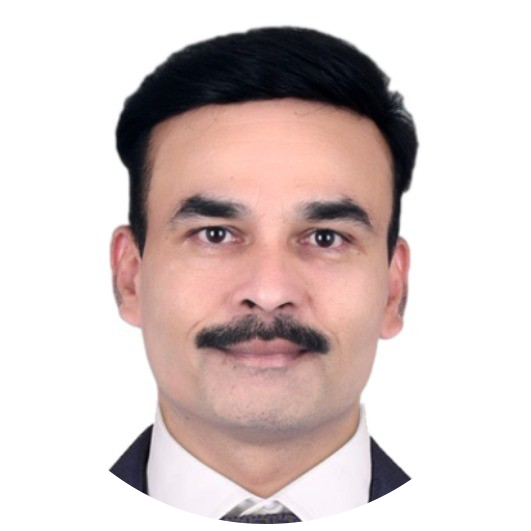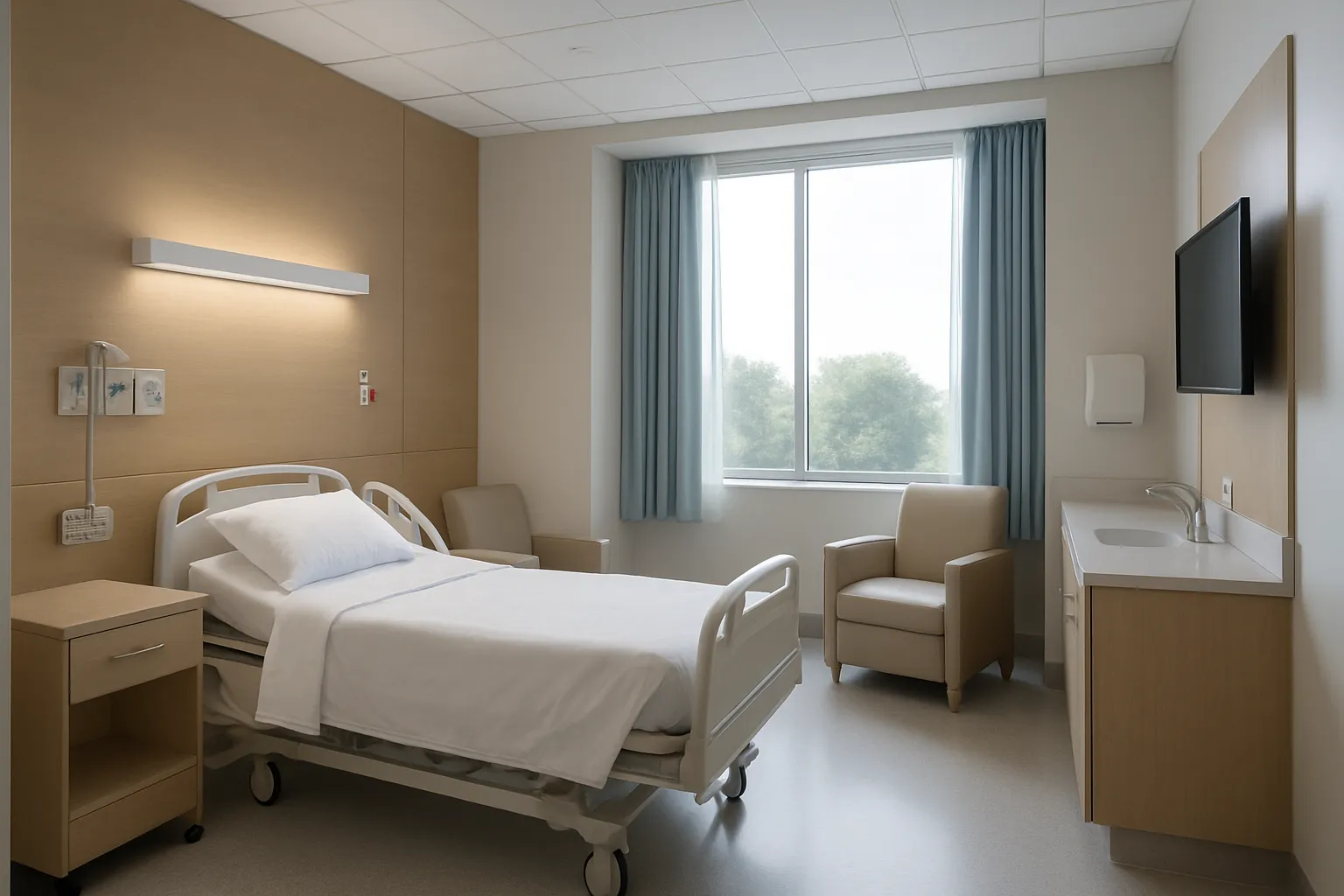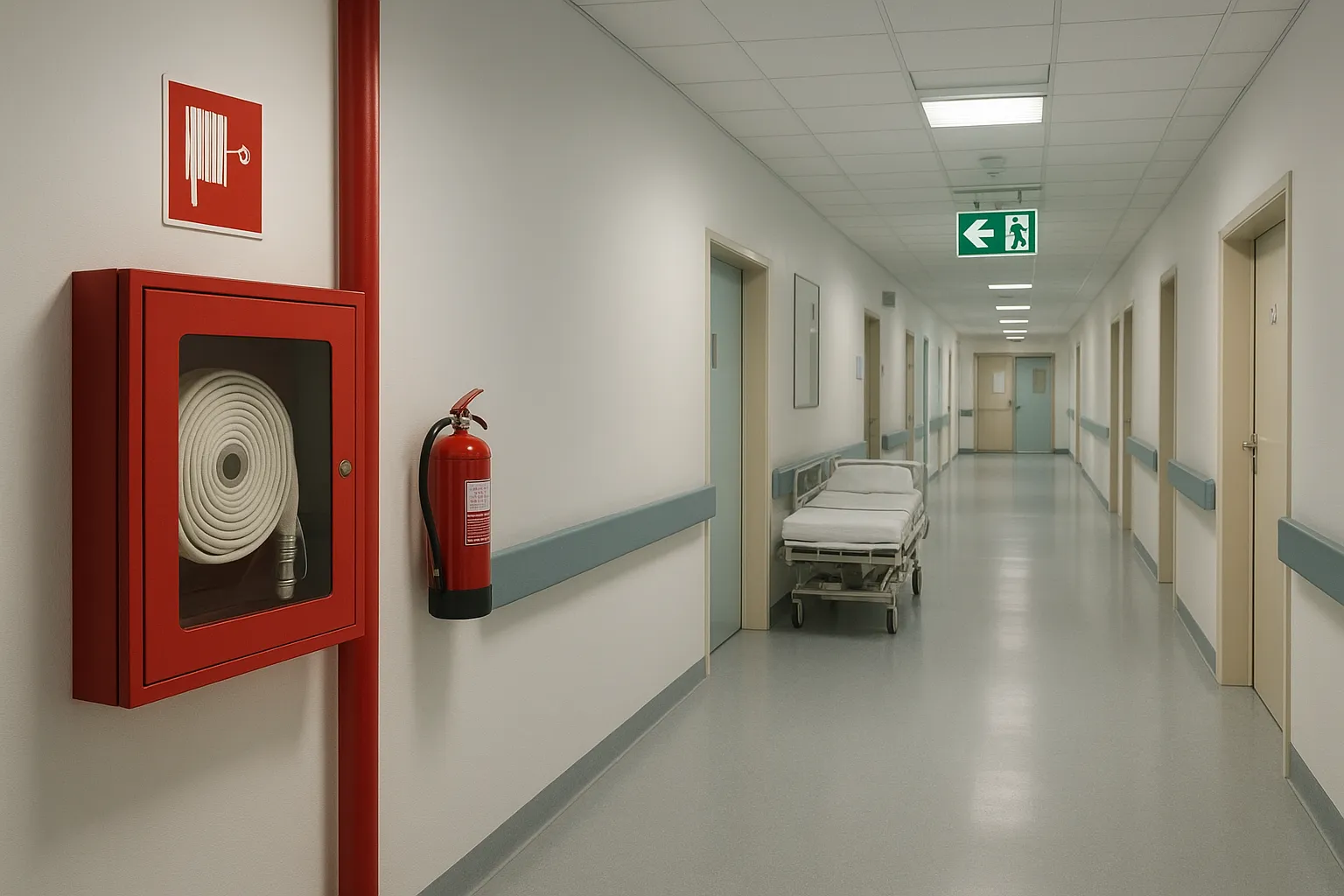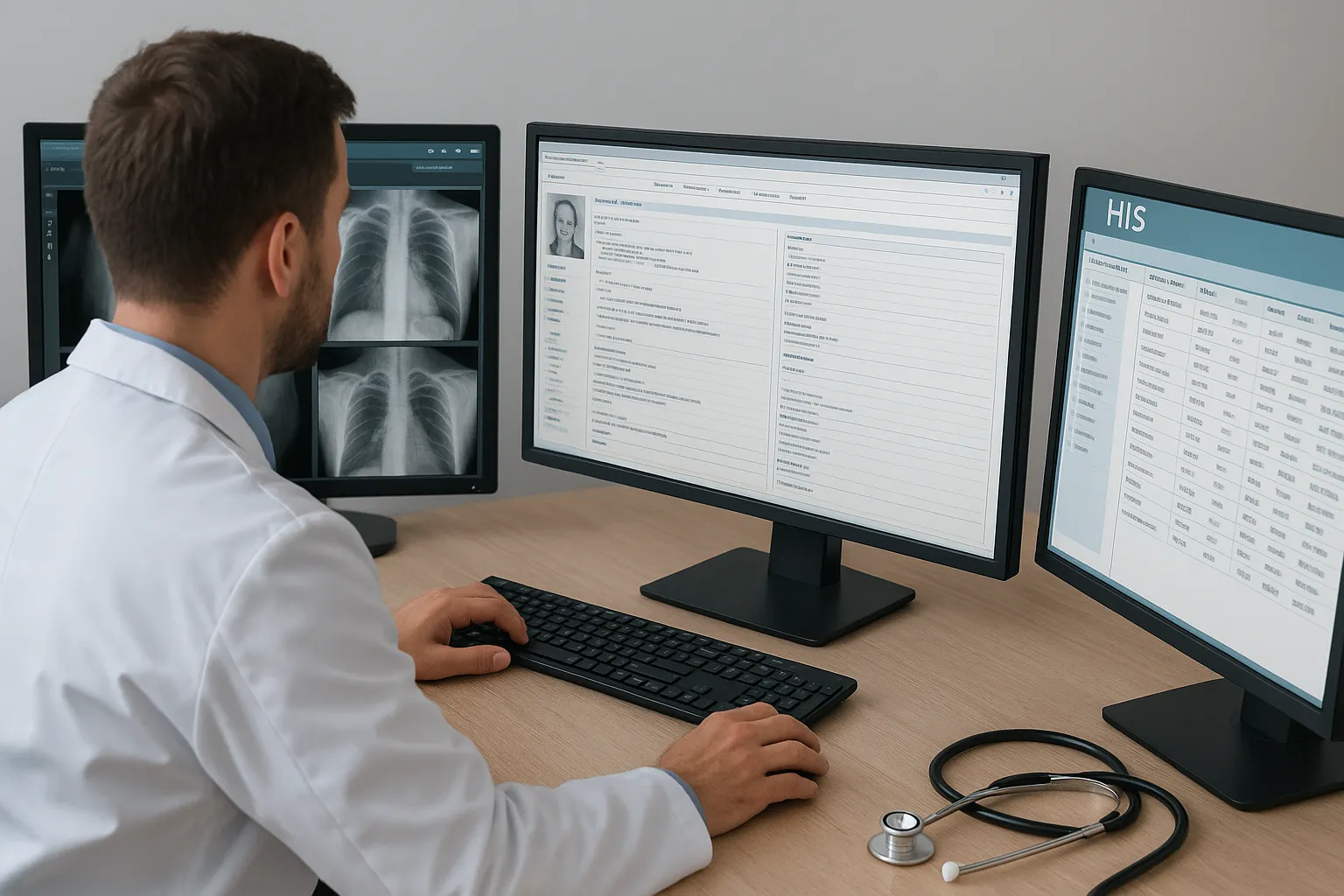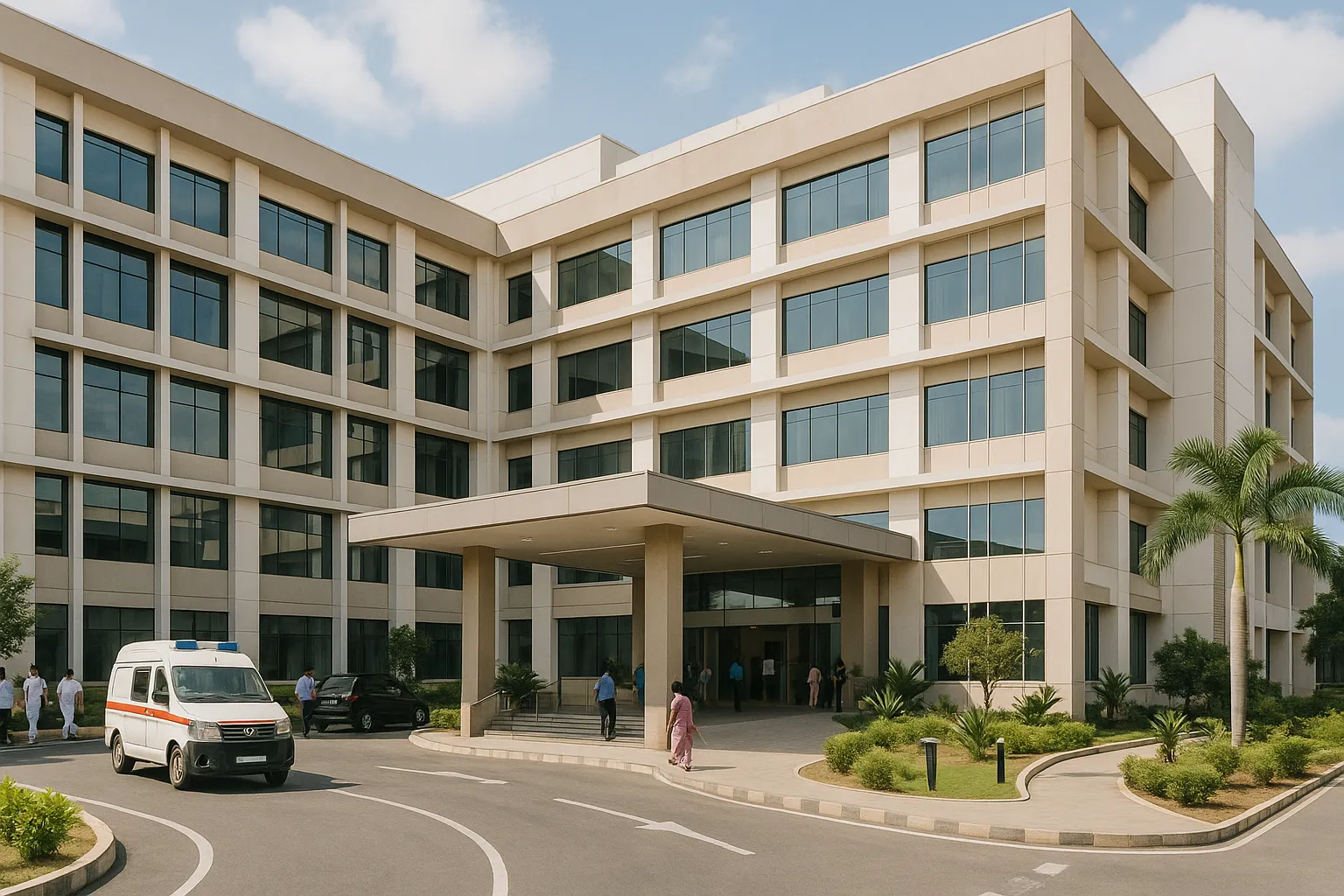How Doctors Can Start Their Own Hospital in India: A Complete Guide
Starting your own hospital in India might feel like an impossible dream, but here's a reality check that might surprise you. According to the National Sample Survey Office (NSSO), India has only 0.5 hospital beds per 1,000 people – far below the WHO recommendation of 3.5 beds per 1,000 people.
This massive gap creates an incredible opportunity for qualified doctors who want to build their own healthcare institutions.
The Indian healthcare market, valued at $372 billion in 2022, is expected to reach $638 billion by 2025. With government initiatives like Ayushman Bharat and increasing health consciousness among Indians, doctor entrepreneurs are finding fertile ground for establishing successful hospitals.
But let's be honest – starting a hospital isn't like opening a small clinic. It requires careful planning, substantial investment, and deep understanding of regulatory requirements. This guide will walk you through every step of the process, from initial planning to opening day.
Understanding the Healthcare Market Landscape in India
Market Size and Growth Potential
India's healthcare sector presents massive opportunities for doctor entrepreneurs. The industry employs over 4.7 million people and accounts for 4% of the total employment. Private hospitals constitute about 74% of total hospitals in India, showing the dominant role of private healthcare providers.
The rural healthcare market alone represents a $6 billion opportunity, with 68% of India's population living in rural areas. Many of these regions lack proper healthcare facilities, creating perfect opportunities for new hospitals.
Government Support and Initiatives
The Indian government has introduced several schemes that benefit new hospitals:
- Ayushman Bharat scheme covers over 500 million beneficiaries
- Production Linked Incentive (PLI) scheme for medical devices
- National Digital Health Mission for digitization
- Various state-specific incentives for healthcare infrastructure
Legal Requirements and Regulatory Framework
Essential Licenses and Registrations
Starting a hospital requires multiple approvals and licenses. Here's what you need:
Primary Registrations
- Medical Council Registration: Your primary medical degree must be registered with the respective state medical council
- Business Registration: Register as a Private Limited Company, Partnership, or Proprietorship
- GST Registration: Mandatory for healthcare services
- Professional Tax Registration: State-specific requirement
Let’s Build Your Dream Hospital
Whether you’re planning a new hospital, expanding an existing facility, or upgrading your healthcare technology, Actiss Healthcare is here to guide you every step of the way. Let us help you turn your vision into reality. Contact us today for a free consultation & learn more about our services and how we can support your next healthcare project.

Healthcare-Specific Licenses
| License Type | Issuing Authority | Validity Period | Annual Fee Range |
|---|---|---|---|
| Clinical Establishment License | State Health Department | 1-5 years | ₹5,000-₹50,000 |
| Fire Safety Certificate | Fire Department | 1 year | ₹2,000-₹10,000 |
| Pollution Control Board NOC | State PCB | 5 years | ₹1,000-₹5,000 |
| Drug License | Drug Controller | 3 years | ₹5,000-₹25,000 |
| Biomedical Waste Authorization | State PCB | 3 years | ₹2,500-₹15,000 |
NABH Accreditation
While not mandatory, National Accreditation Board for Hospitals (NABH) accreditation significantly boosts credibility. NABH-accredited hospitals can charge 15-20% higher rates and attract more insurance patients.
Financial Planning and Investment
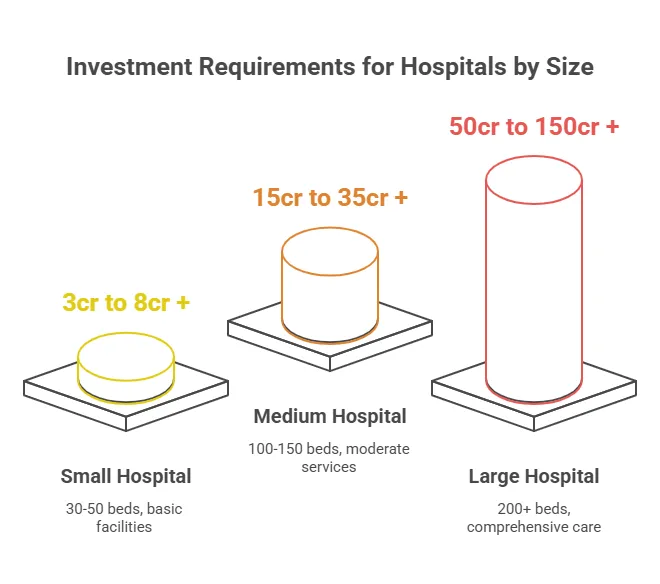
Capital Requirements Breakdown
The investment needed varies dramatically based on hospital size and location. Here's a realistic breakdown:
Small Hospital (30-50 beds)
- Total Investment: ₹3-8 crores
- Land/Building: ₹1-3 crores
- Medical Equipment: ₹80 lakhs-₹2 crores
- Interior Setup: ₹30-60 lakhs
- Working Capital: ₹50 lakhs-₹1.5 crores
Medium Hospital (100-150 beds)
- Total Investment: ₹15-35 crores
- Land/Building: ₹6-15 crores
- Medical Equipment: ₹4-10 crores
- Interior Setup: ₹1.5-3 crores
- Working Capital: ₹3-7 crores
Large Hospital (200+ beds)
- Total Investment: ₹50-150 crores
- Land/Building: ₹20-60 crores
- Medical Equipment: ₹15-50 crores
- Interior Setup: ₹5-15 crores
- Working Capital: ₹10-25 crores
Funding Options Available
Traditional Bank Loans
Most nationalized banks offer healthcare sector loans at competitive rates:
- State Bank of India: 8.5-11% interest rates
- HDFC Bank: 9-12% interest rates
- ICICI Bank: 8.75-11.5% interest rates
- Axis Bank: 9.25-12% interest rates
Government Schemes
Several government schemes support healthcare infrastructure:
- MUDRA Loans: Up to ₹10 lakhs without collateral
- Stand-Up India: ₹10 lakhs to ₹1 crore for women entrepreneurs
- SIDBI Healthcare Fund: Specialized healthcare funding
- State-specific schemes: Various regional incentives
Private Equity and Venture Capital
Healthcare startups raised $1.9 billion in 2022, showing strong investor interest. Key players include:
- Sequoia Capital India
- Accel Partners
- Matrix Partners
- Kalaari Capital
Location Selection and Infrastructure Development
Strategic Location Factors
Demographic Analysis
Your hospital's success heavily depends on location choice. Consider these factors:
- Population density: Minimum 50,000 people within 5km radius
- Age demographics: Areas with aging populations need more healthcare
- Income levels: Middle-class neighborhoods provide sustainable patient flow
- Existing competition: Avoid oversaturated markets
Accessibility Requirements
- Proximity to main roads and highways
- Public transportation connectivity
- Adequate parking space (minimum 1 space per 4 beds)
- Emergency vehicle access
- Future development potential of the area
Infrastructure Planning
Space Requirements
Indian Public Health Standards specify minimum space requirements:
| Hospital Component | Space per Bed (sq ft) | Additional Requirements |
|---|---|---|
| General Ward | 100-120 | Natural ventilation, 7ft minimum height |
| ICU | 150-200 | Central air conditioning, backup power |
| Operation Theater | 400-600 | HEPA filtration, positive pressure |
| Emergency | 80-100 | 24/7 accessibility, ambulance bay |
| Laboratory | 20-30 per bed | Separate entrance, waste management |
Essential Infrastructure Components
Your hospital infrastructure must include:
- Power Systems: Primary connection plus 100% backup generation
- Water Supply: Municipal connection plus borewell backup
- Medical Gas Pipeline: Oxygen, nitrous oxide, compressed air
- Waste Management: Biomedical waste treatment facility
- Fire Safety: Sprinkler systems, fire exits, emergency lighting
- IT Infrastructure: Hospital management system, networking
Medical Equipment and Technology Integration
Essential Medical Equipment Categories
Diagnostic Equipment
- X-ray Machine: ₹8-25 lakhs (digital systems preferred)
- Ultrasound: ₹3-15 lakhs (color Doppler recommended)
- ECG Machine: ₹50,000-₹3 lakhs
- Laboratory Equipment: ₹15-50 lakhs (complete setup)
- CT Scan: ₹1.5-4 crores (for medium to large hospitals)
- MRI Machine: ₹3-8 crores (high-end facilities)
Life Support Equipment
- Ventilators: ₹3-15 lakhs per unit
- Defibrillators: ₹1-5 lakhs per unit
- Patient Monitors: ₹50,000-₹3 lakhs per unit
- Anesthesia Machines: ₹2-8 lakhs per unit
- Dialysis Machines: ₹3-12 lakhs per unit
Technology Integration Strategy
Hospital Management Systems
Modern hospitals need comprehensive HMS for efficient operations:
- Patient Registration: Digital records, insurance verification
- Billing Systems: Automated billing, insurance claims
- Inventory Management: Medicine stocks, equipment tracking
- Appointment Scheduling: Online booking, queue management
- Electronic Medical Records: Digital patient histories
Telemedicine Capabilities
Post-COVID, telemedicine has become essential. Implementation includes:
- High-speed internet infrastructure
- Video consultation platforms
- Remote monitoring capabilities
- Digital prescription systems
- Patient communication tools
Staffing and Human Resource Management
Core Staff Requirements
Medical Staff
| Position | Minimum Qualification | Salary Range (per month) | Ratio (per 100 beds) |
|---|---|---|---|
| Doctors (General) | MBBS + 2 years experience | ₹80,000-₹2,00,000 | 8-12 |
| Specialist Doctors | Post-graduation/Diploma | ₹1,50,000-₹5,00,000 | 4-8 |
| Nurses | GNM/BSc Nursing | ₹25,000-₹50,000 | 60-80 |
| Nursing Supervisors | BSc Nursing + experience | ₹40,000-₹70,000 | 8-10 |
| Pharmacist | D.Pharm/B.Pharm | ₹30,000-₹60,000 | 2-4 |
Support Staff
- Hospital Administrator: MBA/MHA preferred, ₹60,000-₹1,50,000
- IT Support: Technical degree, ₹25,000-₹50,000
- Housekeeping: Basic education, ₹12,000-₹20,000
- Security: 24/7 coverage, ₹15,000-₹25,000
- Kitchen Staff: Food safety certification, ₹15,000-₹30,000
Recruitment Strategy
Finding Quality Medical Professionals
Recruiting good doctors and nurses is challenging. Use these strategies:
- Medical College Partnerships: Connect with local medical colleges
- Professional Networks: Medical associations, online platforms
- Competitive Packages: Offer above-market salaries and benefits
- Growth Opportunities: Promise skill development and career advancement
- Work Environment: Create positive, professional workplace culture
Retention Strategies
High staff turnover hurts hospital reputation and increases costs:
- Regular salary reviews and performance bonuses
- Continuing medical education opportunities
- Health insurance and family benefits
- Flexible working arrangements where possible
- Recognition programs and team building activities
Marketing and Patient Acquisition
Pre-Launch Marketing Strategy
Community Engagement
Start building relationships before opening:
- Free health checkup camps in nearby areas
- Tie-ups with local schools and organizations
- Participation in community health programs
- Partnerships with local doctors for referrals
- Sponsorship of health-related events
Digital Presence
Modern patients research hospitals online before visiting:
- Professional website with services and doctor profiles
- Google My Business listing with accurate information
- Social media presence on Facebook and Instagram
- Online appointment booking system
- Patient testimonials and success stories
Insurance and Corporate Tie-ups
Health Insurance Partnerships
Insurance patients provide steady revenue streams:
| Insurance Provider | Market Share | Empanelment Process | Payment Terms |
|---|---|---|---|
| ESIC | Government employees | Application-based | 90-120 days |
| CGHS | Central government | Tender process | 60-90 days |
| Private Insurance | Individual/Corporate | Agreement-based | 30-60 days |
| Ayushman Bharat | BPL families | Online application | 45-60 days |
Corporate Wellness Programs
Local businesses need healthcare services for employees:
- Annual health checkup packages
- Occupational health services
- Emergency medical services
- Employee insurance coverage
- Health awareness programs
Quality Assurance and Accreditation
Quality Management Systems
International Standards
Implementing quality standards improves patient care and hospital reputation:
- ISO 9001:2015: Quality management system certification
- NABH Standards: Indian healthcare accreditation
- JCI Accreditation: International gold standard (for premium hospitals)
- NABL Accreditation: Laboratory quality standards
Patient Safety Protocols
Establishing safety protocols prevents medical errors:
- Medication administration protocols
- Infection control procedures
- Patient identification systems
- Emergency response procedures
- Incident reporting mechanisms
Continuous Improvement Process
Performance Monitoring
Track key performance indicators:
- Patient satisfaction scores: Target above 85%
- Average length of stay: Minimize unnecessary days
- Readmission rates: Keep below 5%
- Infection rates: Hospital-acquired infections below 2%
- Staff turnover: Keep below 15% annually
Financial Management and Revenue Optimization
Revenue Stream Diversification
Primary Revenue Sources
- Inpatient services: 60-70% of hospital revenue
- Outpatient consultations: 15-25% of revenue
- Diagnostic services: 8-15% of revenue
- Pharmacy sales: 5-10% of revenue
- Emergency services: 3-8% of revenue
Secondary Revenue Opportunities
- Corporate health checkup packages
- Medical tourism services
- Training programs for medical professionals
- Research and clinical trials
- Equipment rental to other healthcare providers
Cost Optimization Strategies
Operational Efficiency
Reduce costs without compromising quality:
- Energy Management: LED lighting, efficient HVAC systems
- Inventory Optimization: Just-in-time medication purchasing
- Staff Productivity: Cross-training, efficient scheduling
- Technology Automation: Reduce manual processes
- Preventive Maintenance: Reduce equipment downtime
Financial Controls
Implement strong financial management:
- Daily revenue monitoring
- Monthly budget reviews
- Cash flow forecasting
- Bad debt management
- Insurance claim tracking
Common Challenges and Solutions
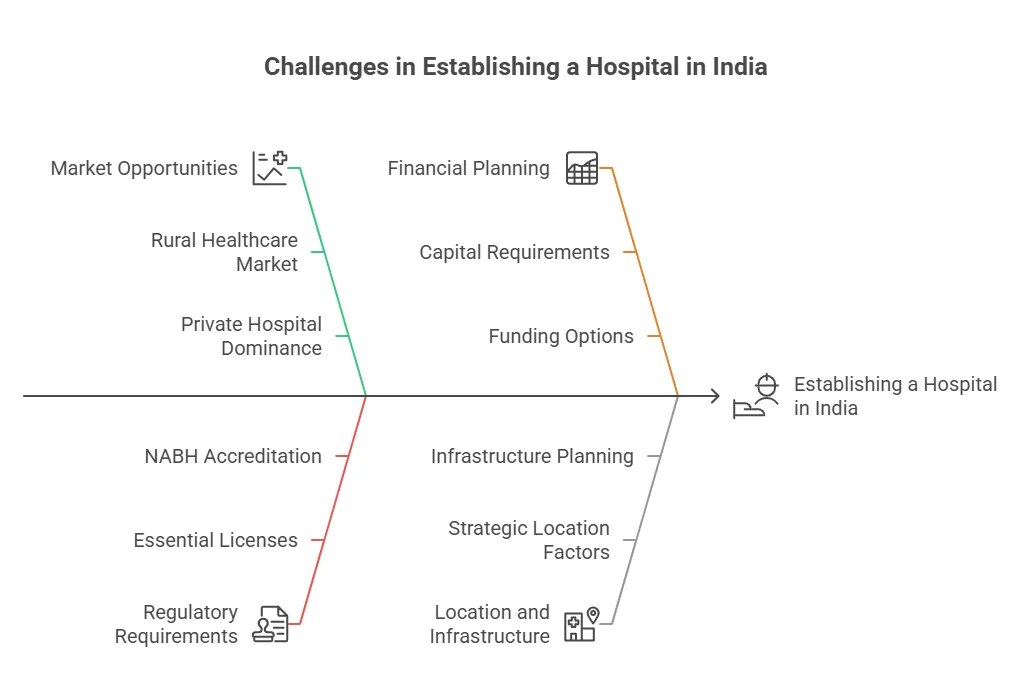
Regulatory Compliance Issues
Common Compliance Problems
Many new hospitals face these issues:
- License renewals: Late applications cause operational delays
- Fire safety violations: Regular inspections reveal gaps
- Biomedical waste management: Improper disposal leads to penalties
- Drug storage: Temperature control and inventory issues
- Staff certification: Expired licenses affect operations
Preventive Solutions
Stay ahead of compliance issues:
- Maintain a compliance calendar with renewal dates
- Conduct quarterly self-audits
- Train staff on regulatory requirements
- Hire compliance officers for larger hospitals
- Regular consultation with healthcare lawyers
Financial Management Challenges
Cash Flow Problems
Healthcare businesses often face cash flow issues:
- Insurance claim delays: 30-120 day payment cycles
- High operational costs: 24/7 operations increase expenses
- Equipment financing: Heavy machinery requires significant investment
- Staff salary obligations: Cannot delay payments to medical staff
- Emergency expenses: Unexpected equipment failures
Financial Solutions
Maintain healthy cash flows:
- Diversify payment sources (cash, insurance, corporate)
- Negotiate better payment terms with insurance companies
- Maintain emergency funds equal to 3-6 months operating expenses
- Invoice factoring for immediate cash from unpaid bills
- Regular financial planning and forecasting
Technology Trends and Future Considerations
Emerging Healthcare Technologies
Artificial Intelligence Applications
AI is revolutionizing healthcare delivery:
- Diagnostic imaging: AI-assisted radiology interpretation
- Predictive analytics: Early warning systems for patient deterioration
- Drug discovery: AI-powered pharmaceutical research
- Robot-assisted surgery: Precision surgical procedures
- Virtual health assistants: 24/7 patient support
Digital Health Solutions
Prepare for healthcare digitization:
- Electronic health record systems
- Telemedicine platforms
- Mobile health applications
- Wearable device integration
- Blockchain for secure data sharing
Sustainability and Green Healthcare
Environmental Considerations
Modern hospitals must consider environmental impact:
- Energy efficiency: Solar panels, LED lighting systems
- Waste reduction: Digital records, reusable materials
- Water conservation: Rainwater harvesting, recycling systems
- Green building certification: LEED or similar standards
- Sustainable procurement: Environmentally friendly supplies
Success Stories and Case Studies
Small Hospital Success Story
Dr. Rajesh Kumar started a 40-bed specialty orthopedic hospital in Pune with ₹5 crores investment. His strategy focused on:
- Specialization in joint replacement surgeries
- Partnership with sports clubs for athlete treatment
- Investment in advanced arthroscopy equipment
- Building strong relationships with referring doctors
Within three years, his hospital achieved 70% bed occupancy and ₹2 crore annual profit.
Rural Healthcare Success
Dr. Priya Sharma established a 60-bed multi-specialty hospital in rural Karnataka with ₹8 crores investment. Her approach included:
- Government scheme empanelment for rural coverage
- Mobile health units for outreach services
- Telemedicine consultations with urban specialists
- Community health worker training programs
The hospital now serves 200,000+ rural population and maintains 65% occupancy rates.
Conclusion
Starting your own hospital in India requires significant planning, investment, and dedication, but the opportunities are substantial. With India's growing healthcare needs and supportive government policies, doctor entrepreneurs can build successful healthcare businesses while serving their communities.
The key to success lies in thorough preparation – from choosing the right location and obtaining necessary licenses to implementing quality systems and building strong teams. While the initial investment might seem overwhelming, proper financial planning and phased development can make hospital ownership achievable for many doctors.
Remember, hospital ownership isn't just about business success – it's about creating lasting impact on community health while building a sustainable healthcare enterprise. With careful planning and execution, your hospital can become both a profitable business and a vital community resource.
Start small if needed, but start with a clear vision and commitment to quality healthcare delivery. Your journey from doctor to hospital owner might be challenging, but the rewards – both financial and personal – make it worthwhile.
Frequently Asked Questions
1. What is the minimum investment required to start a small hospital in India?
The minimum investment for a 30-50 bed hospital ranges from ₹3-8 crores, depending on location and specialization. This includes land/building costs (₹1-3 crores), medical equipment (₹80 lakhs-₹2 crores), interior setup (₹30-60 lakhs), and working capital (₹50 lakhs-₹1.5 crores). Rural areas typically require lower investment compared to metropolitan cities.
2. How long does it take to obtain all necessary licenses for starting a hospital?
The licensing process typically takes 6-12 months if all documentation is proper. Key licenses include Clinical Establishment License (2-3 months), Fire Safety Certificate (1-2 months), Pollution Control Board NOC (2-4 months), Drug License (1-2 months), and Biomedical Waste Authorization (2-3 months). Starting the application process early and hiring experienced consultants can expedite approvals.
3. Can a single doctor start a hospital, or do I need multiple doctor partners?
A single qualified doctor can start a hospital, but having multiple doctor partners offers several advantages: shared financial burden, diverse medical expertise, wider patient referral network, and better risk management. Solo practitioners often start with smaller facilities and gradually expand by bringing in specialist partners.
4. What are the most profitable hospital specializations for new entrants?
The most profitable specializations include orthopedics (joint replacements, sports medicine), cardiology (cardiac catheterization), gastroenterology (endoscopy procedures), gynecology (maternity services), and ophthalmology (cataract surgeries). These specialties have high procedure volumes, good insurance coverage, and strong demand across both urban and rural markets.
5. How can I secure funding if I don't have sufficient personal capital?
Several funding options are available: bank loans at 8.5-12% interest rates (most common), government schemes like MUDRA loans and Stand-Up India, private equity/venture capital for larger projects, equipment financing for medical devices, and partnerships with established healthcare groups. Many successful hospital owners start with bank loans covering 60-70% of project cost while arranging the remainder through personal savings and small investors.


